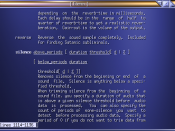Visual Embeds in Advertising Have you ever been to a movie and suddenly had a strong craving for some popcorn, or a soda, even if you're not the least bit hungry? Your intense craving might be a result of Visual Embeds. Visual Embeds, also known as Subliminal Projection, is "a technique of projecting information below the viewing audience's threshold of sensation or awareness. It involves flashing a message lasting only a fraction of a second on the television screen. Theoretically, a viewer could receive such a message without realizing he or she had observed it"� (FCC Board 3). Think about that definition for a second. The actuality of this surreal idea is quite scary. To think that advertisers know of a method to manipulate the way our minds think, and to do it in such a style that we are not even aware of it, is a very discomforting feeling.
And many people brush off the idea of Subliminal Projection because they don't believe that it is real, or there is no scientific proof. The business of Subliminal Projection has been around for about fifty years. And ever since, there has been a pending argument whether subliminal messages are just a theory, or are a scientific fact. However, with all the statistics that have been released about Subliminal Projection research, there should not be a question of the method's potency. Subliminal Projection does effect one's mind, and is absorbed subconciously into the brain.
The first known experiment with Subliminal Projection occurred in 1956 when a man named James Vicary thought he might boost snack bar sales by flashing subliminal messages during a motion picture. Mr. Vicary installed a special projector camera in his New Jersey movie theatre that was set to flash two messages, "Drink Coke"�, and "Hungry? Eat...


